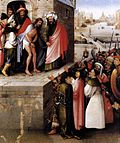Hieronymus Bosch
Hieronymus Bosch, (born Jeroen Anthonissen van Aken, c. 1450 – 9 August 1516) was an early Dutch painter. He lived, worked and died in 's-Hertogenbosch, a Dutch town. This was then the capital of the Duchy of Brabant, a region which included much of modern Belgium and Holland.
| Hieronymus Bosch | |
|---|---|

| |
| Hieronymus Bosch | |
| Birth name | Jeroen Anthonissen van Aken |
| Born | c. 1450 |
| Died | 9 August 1516 's-Hertogenbosch, The Netherlands |
| Field | Painting, drawing |
| Movement | Renaissance |
| Influenced | Pieter Brueghel the Elder Surrealism, Salvador Dali |
Many of his works depict temptation, sin and punishment in hell. The paintings have a dreamlike surreal quality, with sexual and sadistic images. The intent was probably serious, to warn of the punishment which awaited sinners in hell.
The paintings often look like, and certainly did influence, the modern art movement known as surrealism. Bosch used images of demons, half-human animals and machines, to evoke fear and confusion, and to portray the evil of man. His works contain complex, highly original, imaginative, and dense use of symbolic figures and iconography, some of which was obscure even in his own time.
Today only 25 paintings are known to be by him; Philip II of Spain collected some of the best, which are now in the Prado Museum, Madrid.




